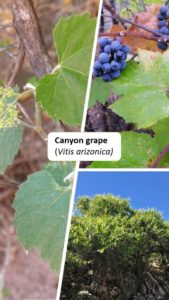
Photo Credit: SEINet Portal Network. 2020.http//:swbiodiversity.org/seinet/index.php. Accessed July 2020.
For this week’s Friday Flora Feature, we’re spotlighting Vitis arizonica, a grape species we often see while seeking water resources in the Sky Island region. Keep reading to learn how to identify this species when you’re out hiking, camping, or helping us monitoring our springs.
Description:
Vitis arizonica, commonly called canyon grape, Arizona grape, or Jiragui in Spanish, is a wetland plant that flowers between April and July and bears blueish-purple fruit clusters.
Canyon grape grows very similarly to domesticated grape vines: it has broad green lobed leaves (some naturalists describe them as “maple-like leaves”) with wide serrations along the edges, woody branches, and clusters of green flowers. Each plant is either male or female, not both, so canyon grape either have stamens or carpels for pollination. Canyon grape plants are perennial and grow back every year.
Habitat:
The canyon grape is native to the southwest and prefers to grow near wet areas, such as streambanks, rivers, or in shady canyons. Canyon grape plants will grow over rocks, shrubs, or along trees—in some places going so far as to completely cover and overcome an existing tree or bush.
While the fruits of the canyon grape plant are edible, they are not very palatable for humans (though they have traditionally been used for food by Native American tribes, according to Southwest Desert Flora). The fruits are smaller than the average grape and contain extra seeds. It’s for this reason the fruits produced by canyon grape plants are mostly eaten by birds and small animals.
The canyon grape also supports a specific species of seed beetle in the southwest, Amblycerus vitis. This beetle lays eggs on a cluster of grapes. Upon hatching the larvae will bore into the fruit and make a home in one of the seeds, where they will pupate and become an adult.
Status:
Canyon grape can be found across the southwestern United States and in parts of Mexico. In Arizona, canyon grape grows most abundantly at elevations between 2,000 and 7,500 feet (source: SEINet) and is not often found outside these preferred elevations.
Fun fact: In Ohio, Vitis arizonica is considered a noxious weed.
Identification Tips:
Here are some traits to look for when identifying canyon grape:
- Perennial vine plant near steady water sources
- Broad, maple-like green leaves with wide serrations
- Woody branches and long brown, forked leaf stems
- White or green flower clusters
- Round blue/purple grape clusters when fruiting
- Growth to a maximum height of 12 feet
Search for canyon grape in the wild! Become a volunteer of our Spring Seeker program.

A close look at the grape clusters and leaves that grow on a Vitis arizonica plant. Photo credit: Max Licher, SEINet Portal Network.
